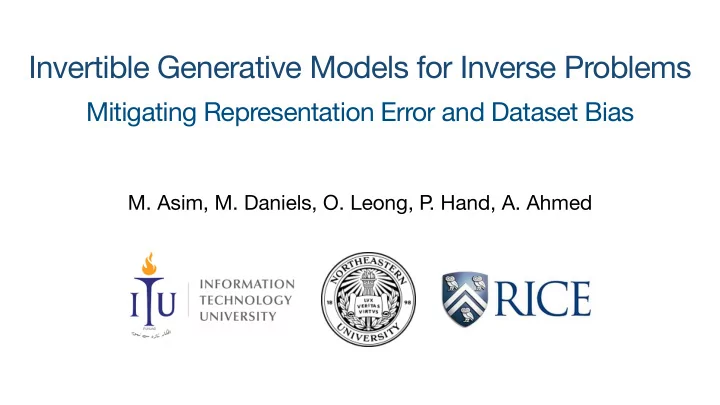

Invertible Generative Models for Inverse Problems Mitigating Representation Error and Dataset Bias M. Asim, M. Daniels, O. Leong, P . Hand, A. Ahmed
Inverse Problems with Generative Models as Image Priors
Inverse Problems with Generative Models as Image Priors
Inverse Problems with Generative Models as Image Priors
Inverse Problems with Generative Models as Image Priors
Contributions 1. Trained INN priors provide SOTA performance in a variety of inverse problems 2. Trained INN priors exhibit strong performance on out-of-distribution images 3. Theoretical guarantees in the case of linear invertible model
Linear Inverse Problems in Imaging
Invertible Generative Models via Normalizing Flows • Learned invertible map • Maps Gaussian to signal distribution • Signal is a composition of Flow steps • Admits exact calculation of Fig 1. RealNVP (Dinh, Sohl-Dickstein, Bengio) image likelihood
Central Architectural Element: affine coupling layer A ffi ne coupling layer: 1. Split input activations 2. Compute learned a ffi ne transform 3. Apply the transformation Fig 2. RealNVP (Dinh, Sohl-Dickstein, Bengio) Has a tractable Jacobian determinant Examples: RealNVP , GLOW
Formulation for Denoising Given: MLE formulation over x -space: 1. Noisy measurements of all pixels: 2. Trained INN: Proxy in z -space: Find:
INNs can outperform BM3D in denoising Given: 1. Noisy measurements of all pixels: 2. Trained INN: Find:
Formulation for Compressed Sensing Given: Find: Solve via optimization in z -space:
Compressed Sensing
INNs exhibit strong OOD performance
INNs exhibit strong OOD performance
Strong OOD Performance on Semantic Inpainting
Theory for Linear Invertible Model Theorem: Let . Given m Gaussian measurements ., the MLE estimator obeys
Discussion Why do INNs perform so well OOD? Invertibility guarantees zero representation error Where does regularization occur? Explicitly by penalization or implicitly by initialization + optimization
When is regularization helpful in CS? High likelihood init Regularization by init + opt alg Low likelihood init Explicit regularization needed
Why is likelihood in latent space a good proxy? High likelihood regions in latent space generally correspond to high likelihood regions in image space
Why is likelihood in latent space a good proxy? High likelihood regions in latent space generally correspond to high likelihood regions in image space
Contributions 1. Trained INN priors provide SOTA performance in a variety of inverse problems 2. Trained INN priors exhibit strong performance on out-of-distribution images 3. Theoretical guarantees in the case of linear invertible model
Recommend
More recommend